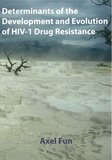Determinants of the Development and Evolution of HIV-1 Drug Resistance

Fun, Axel
- Promoter:
- Prof.dr. E.J.H.J. (Emmanuel) Wiertz
- Co-promoter:
- Dr. M.J.G. (Monique) Nijhuis & dr. A.M.J. (Anne) Wensing
- Research group:
- Wensing Nijhuis , Wiertz
- Date:
- January 19, 2012
- Time:
- 14:30 h
Summary
This thesis describes the development of resistance against antiretroviral drugs from different drug classes that inhibit viral replication by impeding fundamentally different parts of the Human Immunodeficiency Virus (HIV) life-cycle: particle maturation and integration of the viral genome into the host cell DNA. When HIV infects a cell and completes its life-cycle the newly formed virions leave the cell as immature, non-infectious particles. The transition to infectious virus is called maturation. Maturation is triggered by the proteolytic processing by the viral enzyme protease of Gag, the structural polyprotein, into the functional structural proteins. Impaired polyprotein processing results in non-infectious virus and consequently particle maturation is an excellent drug target. Protease inhibitors are an important class of antiretrovirals that inhibit viral replication by binding the viral protease enzyme. Another class of antiretrovirals that is described in this thesis is the experimental class of maturation inhibitors that unlike protease inhibitors not target the protease enzyme but directly target the structural proteins. A third class of antiretrovirals that is described is the integrase inhibitors. They inhibit viral replication by binding the viral enzyme integrase that is responsible for incorporation of the viral genome into the host cell chromosome. Development of resistance varies per drug and drug class. An important explanation for this observation is the difference in genetic barrier to resistance for different drugs. The genetic barrier is defined as the number of mutations that is required and how likely these are selected by the virus to overcome drug pressure. To escape pressure from bevirimat (a maturation inhibitor) the virus requires only one mutation and these resistance mutations do not affect viral replication. We also show that prior treatment with protease inhibitors can have detrimental consequences for the successive treatment with maturation inhibitors. Resistance against raltegravir (an integrase inhibitor) generally requires more than one mutation. All three primary resistance mutations also have a negative effect on viral replication. Hence, secondary mutations are selected by the virus that restore viral replication and/or enhance resistance. We show that already early during treatment, multiple resistant variants can be selected and that the fittest variant becomes the dominant quasi-species. Interestingly, a dominant variant can be replaced by another variant with a different primary resistance mutation or multiple variants representing different resistance pathways can co-exist in the viral population, a feature that is virtually unique for integrase inhibitors. For drugs with a very high genetic barrier to resistance, like darunavir (a protease inhibitor), resistance becomes even more complicated. To escape drug pressure, multiple mutations have to be selected simultaneously which normally doesn’t occur spontaneously. We show that polymorphisms (naturally occurring variations between viral strains) can lower the genetic barrier of darunavir. We have selected in vitro, starting from wild type virus, high-level resistance against darunavir without any known darunavir associated resistance mutations in the target gene. The resistance mutations are likely to be located in the structural proteins, indicating that the interaction between different viral components can be crucial during the development of resistance.